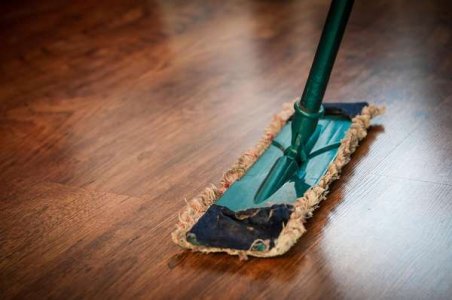Experts reveal the surprising truth about how often you should be mopping your floors!
- Replies 0
Maintaining a pristine home is a source of pride and comfort, particularly for those of us who have cherished our living spaces for decades. The floors, the very foundation we walk upon, can be a canvas of cleanliness or a tapestry of the untold stories of spills, footprints, and the occasional pet mishap.
But how often should we be mopping these silent witnesses to our daily lives? Here are the thoughts and tips of cleaning experts to bring you the definitive guide to keeping your floors sparkling.
Jorge Leiva, the seasoned owner of Bee Maids House Cleaning Services in Houston, Texas, shares that the frequency of mopping your floors isn't a one-size-fits-all affair.
While the general recommendation is to mop at least once a week, particularly in high-traffic areas like kitchens and bathrooms, there's more to consider.
“If you're after a certain level of cleanliness, or if you have a bustling household, you might find yourself mopping more frequently,” Leiva advises. “It's not just about sticking to a schedule; it's about responding to the needs of your home.”
The number of occupants, pets, and even the type of flooring can influence how often you should mop. A single person's abode may require less frequent mopping than a family of five with a furry friend.

Sometimes, your floors will send out an SOS, signaling that it's time to wield the mop. Look out for these clues:
- A dull or dingy appearance that once shone brightly
- Dust bunnies forming their own ecosystems in corners
- Sticky residues that audibly protest with each step
- Grout lines that tell tales of meals past with their grubbiness
- Allergies flaring up, hinting at unseen dust and dander
Before the mopping begins, a crucial step is to sweep or vacuum.
“This prep work ensures you're removing dirt, not just moving it around,” Leiva emphasizes.
He suggests using a flat-head mop with multiple pads for an effective clean, cautioning against the potential pitfalls of traditional mop wringers.
To keep your floors in top condition between mopping sessions, regular sweeping or vacuuming is key.
“Promptly addressing crumbs and spills can prevent damage and maintain cleanliness,” Leiva notes. Additionally, using two doormats at each entrance—one outside and one inside—acts as a double barrier against outdoor grime.
When it's time to invest in a new mop, Leiva steers clear of disposable options.
“They're not cost-effective or eco-friendly,” he points out.
Instead, he champions microfiber mop pads for their ability to trap dirt and leave floors streak-free. These can be used with water alone or with a floor-specific cleaner for a deeper clean.
To become a pro at cleaning while managing your time effectively, read about these tips that will help you make your home sparkle.

How often do you find yourself mopping? Do you have any floor-cleaning secrets that have stood the test of time? Share your wisdom and questions in the comments below!
But how often should we be mopping these silent witnesses to our daily lives? Here are the thoughts and tips of cleaning experts to bring you the definitive guide to keeping your floors sparkling.
Jorge Leiva, the seasoned owner of Bee Maids House Cleaning Services in Houston, Texas, shares that the frequency of mopping your floors isn't a one-size-fits-all affair.
While the general recommendation is to mop at least once a week, particularly in high-traffic areas like kitchens and bathrooms, there's more to consider.
“If you're after a certain level of cleanliness, or if you have a bustling household, you might find yourself mopping more frequently,” Leiva advises. “It's not just about sticking to a schedule; it's about responding to the needs of your home.”
The number of occupants, pets, and even the type of flooring can influence how often you should mop. A single person's abode may require less frequent mopping than a family of five with a furry friend.

Jorge Leiva, owner of Bee Maids House Cleaning Services, advises that floors should be mopped at least once a week. Image source: Michal Jarmoluk / Pixabay.
Sometimes, your floors will send out an SOS, signaling that it's time to wield the mop. Look out for these clues:
- A dull or dingy appearance that once shone brightly
- Dust bunnies forming their own ecosystems in corners
- Sticky residues that audibly protest with each step
- Grout lines that tell tales of meals past with their grubbiness
- Allergies flaring up, hinting at unseen dust and dander
Before the mopping begins, a crucial step is to sweep or vacuum.
“This prep work ensures you're removing dirt, not just moving it around,” Leiva emphasizes.
He suggests using a flat-head mop with multiple pads for an effective clean, cautioning against the potential pitfalls of traditional mop wringers.
To keep your floors in top condition between mopping sessions, regular sweeping or vacuuming is key.
“Promptly addressing crumbs and spills can prevent damage and maintain cleanliness,” Leiva notes. Additionally, using two doormats at each entrance—one outside and one inside—acts as a double barrier against outdoor grime.
When it's time to invest in a new mop, Leiva steers clear of disposable options.
“They're not cost-effective or eco-friendly,” he points out.
Instead, he champions microfiber mop pads for their ability to trap dirt and leave floors streak-free. These can be used with water alone or with a floor-specific cleaner for a deeper clean.
To become a pro at cleaning while managing your time effectively, read about these tips that will help you make your home sparkle.
Key Takeaways
- Jorge Leiva, owner of Bee Maids House Cleaning Services, advises that floors should be mopped at least once a week, especially in high-traffic areas such as kitchens and bathrooms.
- Before mopping, it's crucial to sweep or vacuum the floors to prevent spreading dirt and germs. Using multiple mop pads can be more effective than a mop wringer.
- Regular sweeping or vacuuming, cleaning up spills promptly, and using doormats can extend the time between mopping sessions.
- When purchasing a new mop, Leiva recommends microfiber mop pads for their effectiveness in picking up dirt and being environmentally friendlier compared to disposable pads.
How often do you find yourself mopping? Do you have any floor-cleaning secrets that have stood the test of time? Share your wisdom and questions in the comments below!






